Southport Village Voices
An E-Magazine by & for the Residents of Southport
Number 70, December 2015
|
|
|
Cranberry House, watercolor, 2015 by Larry Cron
|
| |
|
|
|
|
|
|
|
A Season for Giving
|
The end of 2015 is coming up fast and with it the annual blizzard of pleas for donations from every organization to which we've ever made a contribution.
When I read about the fabled "one percent" and fantasize about what I would do with a few billion dollars, the first thing that comes to mind is buy a private jet so I don't ever have to fly "steerage" on United Airlines again. After that, the most satisfying thing I can think to do with all that money is give it away to people and organizations that need it more than I do.
But we're not billionaires; how can our modest gifts make a dent in a world full of needy people, deserving institutions and worthy causes?
Our charitable giving used to be "scatter-shot," just responsive to requests as they came along. Some of it still is, but now we're more methodical; each year we decide how much we can afford to give away and where we want to focus our efforts. Then we divide the "pie" into about six broad categories, arrange those in priority order, and come up with a "budget" for each. Since there's never enough money to support all the things we care about, this approach helps to guide our choices.
Some donations go to broad, global efforts, like the environment, but for the most part, we like to support local organizations that help people in need here on the Cape, or in Hilo, HI, where our family lives and where we spend part of our year.
The other thing we've learned to do is go online to Charity Navigator to check their rating of an organization before we send a donation. Charities that spend a lot on administration or marketing are not likely to receive a donation from us.
We've not yet been able to afford a private jet, but we've been fortunate in many other ways. We have enough to share, and this is a good time of year to do it.
-------------------------------------------
If you have a story, an essay, a review, a picture, etc. to share, please send it along. Any number can play.
|
|
 |
|
|
|
Southport Pioneers: Building a Community
by Lynn Fulton
|
When my husband Bob and I were considering a move from Pocasset to Southport, we were encouraged to do so by friends already here, for the many amenities, of course, but primarily for the sense of shared community and convivial atmosphere. Since the day of our arrival here on August 8, 2015, we have found that to be the case, and have been increasingly curious to know how this sense of community has come to be.
We had heard talk, as perhaps you have, of the "Pioneers," the first 100 settlers in what was to become the community we know today. So, with a little help from friends, we assembled some of those residents and asked them to talk about what it was like to move into and live here, as Southport was coming into being.
Imagine a world of dirt roads -- dusty or muddy, depending on the weather, with no cable or other infrastructure working as expected, minimal landscaping, buildings under construction well past their expected completion dates, a feeling of promises made but not yet realized. No, not Grey Hawk or Leisure Green in 2015, but Pacific, Kettle and Mainsail in 1998.
|
| |
After hard times in the mid-1990s, Southport's prospects began to improve in 1998.
|
The earliest settlers in the wilderness of the early days at Southport banded together under the leadership of the recently deceased Anne Antonelli and called themselves the Pioneers. In many ways they very much were, as 1998 saw the revitalization of Ron Bonvie's project, begun in the early 1990s only to be thwarted by the financial crisis of the mid nineties. When he had his financial feet back under him, it took a real leap of faith by the second wave of earliest residents to buy in and move to Southport. However, they worked together to build the new community from within, bringing with them a wealth of experience and an abundance of enthusiasm. Shared challenges brought people together in a common cause.
|
| |
An artist's conception of the ballroom that became a reality and the center of Southport social life in 1999.
|
Everyone in the group we spoke with agreed that there were major areas of concern. They brought their issues to Ron Bonvie, who was interested in satisfying their needs but also was juggling a daunting array of financing, infrastructure, permitting, and other issues at the same time. However, he understood that he was not going to sell to more buyers if residents already here weren't satisfied. He was particularly conscientious in addressing issues of safety. So, when Al Benjamin told him that they needed a set of condo rules and regulations, he said yes, go form a committee and tell me what you need.
Clay Buswell suggested that they needed overall landscaping and garden work and planning; Ron said form a committee. Clay and his neighbors did so and actually did much of the work to make it happen. Community fund raising was suggested, specifically for the Cape Cod Samaritans, and Ron said form a committee and raise some money, and he contributed, too.
|
| |
Southport's tradition of group effort and volunteering began early and persists today.
|
This kind of group effort, in which residents continue to bond in a common cause, has become a tradition at Southport. Al Benjamin asked when the woodworking shop would be built... and asked again. Marge Dow suggested a library and she became, of course, the first librarian. Art Colachico couldn't imagine being retired without continuing to do a little barbering, his lifelong livelihood, and so a barbershop was included in the new Village Center.
Eda Stepper was concerned that residents would not have family close by for holiday gatherings, and so organized the first Hanukkah party for ten people -- open to all and now attended by over 100. Sara-Fay Tarlin suggested a variety of meet-your-neighbor activities, which as coffee hours, TGIF get-togethers and social events, have become central to life here. Ron supported such efforts, sponsoring many "Monte Carlo" nights, parking lot barbecues, breakfasts and brunches, open both to residents and potential buyers. He knew that satisfied residents can boost sales.
|
| |
The invitation to the Grand Opening of the new
Village Center, October 15, 1999.
|
Then there were mystery outings. During one particularly memorable event, a bus picked up the participants, drove them around the Upper Cape, Bourne Rotary, etc. and pulled into the parking lot at Zachary's! The leader hopped out, stepped into the restaurant and returned announcing "April Fools" - to the possible disappointment of some passengers. Then the bus took them to Oliver's for a traditional Cape Cod supper.
The major concerns of the earliest arrivals were around the completion of the infrastructure and major amenities. The golf course was more dream than reality, there were no tennis courts, the pools had been begun but were under construction, and the Village Center was a construction site visited only by invitation and wearing a hard hat.
Tours of Southport were in golf carts with promises of what would soon be a reality. Sometimes residents were concerned that development was taking precedence over a livable community and encouraged members of town government to become aware of progress and problems. A member of Town Planning came and "hugged some trees" which helped to preserve some of the sense of established landscaping felt in Phase I.
Clearly, the promised infrastructure and amenities were completed. When the Village Center was ready for use, Ron held an "elegant evening of dinner and dancing" in the ballroom. The party was a rousing success, with wonderful food, libation and music
-- particularly remembered for a power outage that interrupted Ron's speech -- caused by a traffic accident on 151, not a Southport problem!
It is to the Pioneers that those of us who are newer owe much of what makes Southport so special. As they said to me at the end of our meeting, "Ron envisioned a village. With his help the residents have created a community. We feel as though we live among family."
|
| |
Pioneers and friends celebrating the 90th birthday of one of their own -- Al Benjamin --
in Lido Beach, Florida.
|
Thanks to the Pioneers who met with Bob and me on November 12, by the fireplace in our beautiful Village Center: Marie Butler, Sandi Abrams, Barbara Webber, Betty and Bill Kelley, Ginnie Pender, Eda and Marty Stepper, Al and Lorraine Benjamin, Don Scholl and Sara-Fay Tarlin. (Please accept my apologies if I've left anyone out.) Also, our next-door neighbor Mary Julio.
Particular thanks to Ginnie Pender and Eda Stepper for sharing the Southport memorabilia they have collected. We need a formal archive! I guess that's an opportunity to form another committee.
In memory of Anne Antonelli
|
|
Seasonal Memories
by Carl Zuanelli
|
In the winters of my teen years, I worked after school as a stock quotation courier for RCA Communications in New York City's financial district. Every December, a huge Rockefeller Center-like Christmas tree was erected there, in the center of Broad Street, eliminating vehicle traffic for three all too brief weeks.
 The tree was typically set and anchored just opposite the Chase Bank Currency Museum, named after Salmon P. Chase, bank founder and Abraham Lincoln's Treasury Secretary. It was a tad south of the entrance to the New York Stock Exchange, closer to the harbor than the bronze statue of George Washington standing tall at the entrance to the Federal Sub-Treasury Building, now just a tourist attraction. The tree was typically set and anchored just opposite the Chase Bank Currency Museum, named after Salmon P. Chase, bank founder and Abraham Lincoln's Treasury Secretary. It was a tad south of the entrance to the New York Stock Exchange, closer to the harbor than the bronze statue of George Washington standing tall at the entrance to the Federal Sub-Treasury Building, now just a tourist attraction.
Financial securities buy/sell orders came over the office teletype, enveloped with the addresses of now long-gone and forgotten brokerage houses: E. F. Hutten, Bache & Co, Solomon Bros, et al. The dispatcher would send us out into the cold, up Wall Street to Broadway with hand deliveries to cold dark offices, closed since five, but always with a guard at the otherwise vacant reception desks.
I often stopped and stared at a wool ski sweater, white with red reindeers on a black striped field, which was for sale in the window of the haberdasher on the corner of Petticoat Lane and Quentes Slip. It was only $10, but that was a powerful sum when I was earning much less than a dollar an hour, gross. But I had been saving for quite a while and finally bought it. I wore that sweater through college and then some.
It was a slower-paced, un-automated world; the ticker tape machine invented by Thomas Edison was still king, and delivery boys were still necessary. After the sun went down around five in the afternoon, the day would become quite cold, and always accompanied by a strong wind off the harbor, seeming to blow from that noble, welcoming statue provided by the people of France, on an imposing pedestal purchased with donated pennies from American children.
There was a man on the corner of John and Fulton Streets who sold hot roasted chestnuts from a cart with a charcoal fire. The aroma was overwhelming to a hungry youth without food since lunchtime. I would stop between deliveries and buy six hot chestnuts for twenty five cents. I put three into each hand and then stuffed my hands in my jacket pockets to give warmth to fingers and tingle through my whole body.
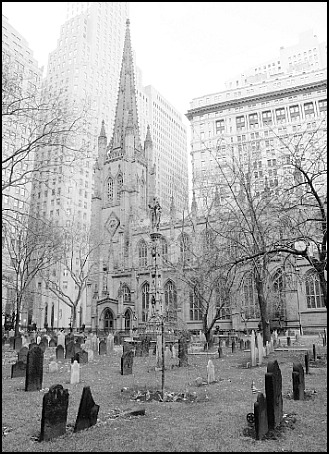 I would sit in the graveyard of old Trinity Presbyterian Church, the oldest church in the city, at the head of Wall Street off Broadway, and listen to the carols of the practicing church choir cascading into the streets. I enjoyed looking at the tombs, carved by unknown stone masons, of Alexander Hamilton, Robert Fulton, deWitt Clinton and other notable citizens, and musing about their roles in our heritage. After the chestnuts had cooled, I peeled and ate them slowly, savoring the flavor, mitigating my hunger, one at a time until the last chestnut was gone. I would sit in the graveyard of old Trinity Presbyterian Church, the oldest church in the city, at the head of Wall Street off Broadway, and listen to the carols of the practicing church choir cascading into the streets. I enjoyed looking at the tombs, carved by unknown stone masons, of Alexander Hamilton, Robert Fulton, deWitt Clinton and other notable citizens, and musing about their roles in our heritage. After the chestnuts had cooled, I peeled and ate them slowly, savoring the flavor, mitigating my hunger, one at a time until the last chestnut was gone.
When I had finished my four-hour shift at 8:00 p.m., I took the Lexington Avenue subway home, starting at Wall Street, then transferring at 180th Street and Morris Park, then again onto the aptly named "dinky," a remnant of the Old Boston and Bronx line that had become part of the NYC subway system long before I was born.
I looked forward to the warmed up dinner my mother had saved for me and would consume it ravenously upon my arrival home, around 9:30 p.m. Then it was hit the books and complete my remaining homework in preparation for the next day. (My unhappy fate since deciding to go to college.) As I fell asleep around eleven or so, I would recall the flavor of those hot chestnuts. Yes, so this was Christmas.
|
|
NON COMPOS MENDES
Bob Mendes
|
- I do this about every two years and apparently it's time to do it again. Enough people have asked me the meaning of NON COMPOS MENDES, so I'll repeat the explanation for those of you who aren't fluent in Latin. "Non Compos Mentis" is Latin for an unsound mind, idiomatically, "Nonsense." I merely changed the spelling of mentis to suit my own needs -- there you are.
- My friend Dick Clarke is seeking the answers to some very important questions:
Why didn't Mrs. Noah tell her husband to kill those two damn mosquitoes?
Why do banks leave their vault doors open, but chain down their pens?
Why does the sun lighten your hair but darken your skin?
How come psychics never win the lottery?
Why is the guy who handles your investments called a broker?
Why don't sheep shrink in the rain?
- Looking through a magazine recently, it occurred to me that the fashion models in the ads always look angry. Since Bette used to do some modeling,I asked her why this is. Her answer: "Look at them, how skinny they all are. They look angry because they're always hungry."
- Newspaper report: "American Pharaoh Stud Fee Set at $200,000" That's a good piece of change for doing what comes naturally. The story went on to say 200 mares were expected to avail themselves of this service, bringing the horse's take to a cool $40 million. That'll buy a lot of soft music and wine.
- Instead of writing a column on procrastination, I think I'll write a whole book on the subject. I'll be starting it pretty soon.
- FOR MEN ONLY Is there any good reason why shoe sizes and sock sizes shouldn't coincide? Recently I looked at a package of socks and learned that they were sized 6 through 13. OK, that's plain enough -- until I read further to find out that they are appropriate with shoes that are sized 9 through 12. Sounds to me like something you'd buy down Alice's rabbit hole.
- I know ISIS is no joking matter, but couldn't we please agree on what we're going to call it. The media call it ISIS (Islamic State in Iraq and Syria) but our present administration calls it ISIL. (The "L" stands for the Levant.) Now, I've always thought "the Levant" was a term that referred to the eastern shores of the Mediterranean, specifically Syria and Lebanon, but sometimes including Turkey, Israel and maybe Egypt and Jordan. The last I heard, Israel, Turkey Jordan and Egypt were the good guys. I don't see how we can defeat an entity when we can't even find a name for it. But what do I know?
- The next edition of NON COMPOS you read (or don't) will be dated January first. I know a lot of people make New Years' resolutions and I'd be happy to print some if anyone wants to share. I'll either attribute it to you, or print it anonymously, whichever you prefer. If you want to participate, call me or send an e-mail to bob246oncape@gmail.com. If you prefer, you could write it on the back of a Berkeley-Hathaway stock certificate and mail it to me.
- FINAL THOUGHT Add a name to your list of incomparable geniuses -- Oscar Hammerstein II. Not only did he write the lyrics for Oklahoma!, My Fair Lady, The King and I and so many other legendary Broadway musicals, He also wrote these words for the king in The King and I.
I DO MY BEST
FOR ONE MORE DAY"
Can you think of any better words to live your life by?
|
|
New in the Neighborhood
Snapshot Interviews & Photos
by AndyJablon
| |
Barb Coutinho, Emily & Tom Williams
74 Grey Hawk Drive, Moved in September 2015
Originally From:
Barb: Winthrop, MA;
Tom: Salem, MA
How They Met: Barbara was guidance councilor to Tom's daughter Emily, who introduced them to each other.
Previous Residence: Amesbury, MA
What Kind of Work Did You Do?
Barb: Guidance director in Byfield Public Schools; Tom: Managed a warehouse and distribution center. Emily is a student at Worcester State University and will be studying in South Africa in the spring.
Why Southport: Barb has been coming to the Cape for a long time. They wanted an adult community.
Like Best About Southport: Friendly people and diverse activities. "We really like our neighbors. SP feels like a resort." Emily: "When I visit, I can tell my parents are really happy here."
Like Least: No recycling and lack of parking near our home
Want To Get Involved With: Barb: Social activities, exercise, yoga, mah jong, Women's Coffee; Tom: Woodworking, billiards, TGIFs, Men's Coffee
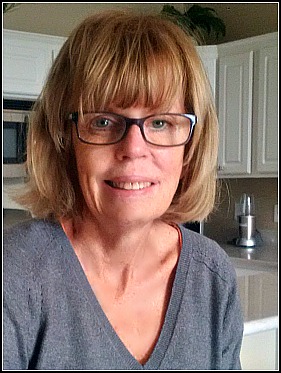 Janet Looney Janet Looney102 Leisure Green Drive,
Moved in November 2015
Originally From: Cambridge, MA
Previous Residence: Woburn, MA
What Kind of Work Did You Do?
Elementary and middle school teacher, Cambridge Public Schools; currently doing literary coaching with teachers
Why Southport: Father lives in Hyannis so knows the Cape well. Southport as an active adult community offered me a lot to do.
Like Best About Southport: Very friendly people and a wide range of activities
Like Least: No recycling
Want To Get Involved With: As many activities as I can, especially golf, fitness, and meeting new people.
|
|
Wednesdays with Dom
by Bob Keeling
|
I started working with Hospice and Palliative Care in Hyannis (now Hope Health of Cape Cod) in 2002 as a patient volunteer. After many assignments with hospice patients and their families, I was asked in 2004 to be a patient volunteer for Dominic Gattozzi, age 89, of Mashpee. I was told that Dom had two weeks to live and that he was known in the community as the "Pied Piper."
When I first met Dom, he was very ill, but he was glad to see me and greeted me with a warm smile that I soon learned was natural for him. Dom's hospice team of nurses, aides and others had been assembled before I joined them, and Dom and his wife Olive seemed pleased and encouraged by the care they were receiving.
The two-week forecast regarding Dom's life expectancy turned out to be wrong; he survived for two and a half years, which became some of the most memorable times of my life. In the early days of Dom's recovery he seemed to find an inner strength that basically said, "I am not giving up!" His family told me many times that the hospice team gave him the hope and encouragement to live on.
Dom became stronger, so he decided it was time to venture outside of his house on Wednesdays. Some of our activities included going for a car ride for an hour or so and visiting the beach. Dom showed me his secret spot where he liked to go quahoging and made me swear to never divulge its location to anyone. We laughed about that, but deep down, I think he meant it!
As Dom became even stronger, we went for longer rides. We had lunch at his favorite restaurants and found that we shared the same tastes in food - especially fried oysters, not overcooked, from Wimpy's in Osterville. Yum! Once, we took a ride around the Woods Hole Golf Club in a golf cart. The weather was perfect. I drove slowly and very cautiously, giving him time to soak it all in. He loved it!
During our adventures, we often talked about Dom's past and his future. He grew up as a first generation child from Italy and worked hard to get ahead. In his later years, he managed a warehouse in Texas. He loved gardening in his backyard and was known as the "Pied Piper" for his generosity in sharing his vegetables with the neighborhood. Young children flocked to his garden to learn about the plants and to carry some of Dom's goodies home.
Dom knew his time in this life was limited but he didn't dwell on that fact. Over the two and a half years I spent with him, mostly on Wednesdays, I began to see him as my surrogate father. He was a gentle, warm, loving and especially giving man. His son Bernie, who lives in Colorado and Florida, and I still share a brotherly closeness. I am grateful that I could offer his Dad support on a local basis.
About a year after I became Dom's hospice volunteer and friend, I told him I had some good news and some more good news. When I asked him and Olive which they wanted to hear first, they both looked at me, confused, and we all laughed. So, I gave them the better news first - he was no longer eligible for hospice care. He was too healthy! But they both looked very disappointed. Then I gave them the other good news -- I would never stop being his friend. We would continue to meet every week and, if necessary, I would bring hospice care back.
In 2006, hospice care was reinstated as Dom's age and declining health worked against him. He never complained and was glad to have the full team back again. If I could think of one important message to this story (and I know Dom and Olive would agree), it would be: Please don't wait until the last few days or weeks of a person's life to use hospice care. For many people, the hesitancy to seek hospice care seems to be the word "hospice" itself. But families should be practical in determining what kind of care is best for the patient -- and for themselves as caregivers. For Dom and his family, I believe hospice worked to the fullest.
Dom, it was never a chore to be with you all those Wednesdays. I received far more than I could ever have imagined. May your soul rest in peace.
|
FACT CHECKING
On Refugees & Politicians
by Richard Vengroff
|
The current posturing about Syrian refugees by many of our nation's politicians, of both parties, is embarrassing and disgraceful. They know, or should know, that:
The image we see daily of asylum seekers flooding into Europe is not in any way reflective of the refugee process in the United States. Refugees coming to the U.S. do not self select but are carefully chosen and vetted by the U.S. State Department, Homeland Security, Department of Health and Human Services and the UN High Commission for Refugees.
There are currently about 18 million refugees in the world, four million of whom are Syrians. From those four million the U.S. will carefully screen and select about 15,000 (less than ½ of 1%) to come to this country in 2016. Most of these are families, a majority of whom are composed of women and young children in severe danger of being killed in their home country by the Assad regime, ISIS, or other terrorist groups.
The vetting process for refugees before they are selected and approved to come to the U.S. takes a minimum of two years (usually much longer in my experience working with refugees).
Upon arrival in the U.S., refugees receive up to three months assistance from non-profits, through donations and government grants, to help them find housing, jobs, English language classes and for registering their children in school. Before leaving their refugee camps to travel to the U.S., those selected are required to sign promissory notes to repay the cost of their airfare. Syrian refugees who are selected to come to the U.S. are people who desperately need our help. They would rather go back home to Syria but have a well-founded fear of doing so.
Would-be terrorists, like all of the 9-11 murderers, are seeking easier, less risky and much quicker ways to come to the U.S. than the refugee route. For example, the U.S. regularly issues between 10 and 12 million temporary, non-immigrant visas a year for tourists, students, business people and others. This is the preferred path for those who would do us harm. If we are serious about stopping terrorists from coming to the U.S., this is where we need improved monitoring systems. Anti-refugee sound bites do not produce serious policy action.
Using Syrian refugees as scapegoats while taking no action on serious potential opportunities that terrorists seek to use to harm us does not make our country safer. The outrageous rants by unethical politicians and some so-called journalists serves only to erode the values that we as Americans hold so dear, and provides propaganda victories for our enemies in ISIS and Al Quaeda.
|
POETRY
Pieces of Dream
by Lydia Biersteker
|
We met up in a dream,
a supermarket happenstance,
her wild gray eyes sought
me out in the maze of cart
wielders. She spoke incessantly.
She called me by name as
if she knew me, she said
her name was Darlene but
I didn't know her. I don't know
any Darlene. I tried to beg
off but she was gabby and
arm grabby and she said she
knew my sister. I softened
and I looked into her face.
"I have no sister," I told this
woman in my dream. "But
you did," she said. And I did.
But she died when I was
just an infant. "Nice meeting
you," I told her, "I've got to
go," shaking off her grasp,
shaking off the dregs of sleep.
|
|
It's All in How You Say It
by Joyce Chasson
|
When the Americans with Disabilities Act (ADA) was passed 25 years ago, those of us in the disability community were ecstatic; finally, architectural barriers and employment discrimination would fade into oblivion. Nothing, of course, is ever that simple, and although enormous progress has been made on many fronts, I find that a lack of awareness persists on how best to communicate with someone who has a significant disability.
A case in point is a recent shopping experience at a local clothing store. I bustled in with my guide dog Jason and a friend, and immediately sensed that the salesperson was uncomfortable. Although I was quite clear on what I was looking for, she began directing all inquiries to my friend: "What is her size?" "Does she wear this color?" "Would she like this sweater?"
My friend was appalled; I was not. The salesperson simply could not grasp the fact that I could make my clothing selections independently without seeing them. The end result, however, was a positive one; humor and a show of appreciation go a long way. I walked out with an outfit, and the salesperson felt a sense of accomplishment.
Speaking through a third party and not addressing a person with a severe impairment directly is quite common in the disability world. I could write a book about my experiences buying appliances, cosmetics, furniture, etc. In my view, it all comes down to exposure and education about how to communicate with someone who has a significant disability. Here are some tips you may find helpful:
* Relax! Don't be afraid to make a mistake. Try to put yourself in the place of the person with a disability and think how you would like to be treated.
*If you offer assistance and it is declined, do not insist. If accepted, ask how you can best help and then follow directions. Do not take over.
*A person is not "wheelchair bound" or "confined" to a wheelchair. Say wheelchair user or a person using a wheelchair; the wheelchair is an auxiliary aid.
*When speaking with someone with a severe speech impairment, don't pretend to understand if you do not; ask the person to repeat the thought or write it down. Be patient.
*When speaking to someone with a hearing impairment, always face the person. Don't raise your voice unless asked to do so. Remember, only 30 percent of the spoken word can be read by watching the lips. Do not cover your mouth.
*Let someone who is blind know who you are; your identity may not be recognized by your voice alone. Be specific when giving directions: "It's over there" and "this way" mean nothing.
*Never pet a guide dog without permission and don't call to the dog when the dog is working.
*The ADA stresses "person first" language. That is, the person is not his or her condition. Say "she has epilepsy," not "She's epileptic," or "He is mobility impaired," not "He's a paraplegic."
My advice: Just be yourself. Let the person with the disability take the lead and relax!
|
|
Happy Endings
Match.Cat?
by Billie Kapp
|
|
| |
Lydia Merchant (left), Joan Bailey and Tigger Keoki
|
No, this match was not made on Match.Cat. Tigger, a lovable cat, met Lydia, a cat lover, through a story in the November issues of FOCUS and Southport Village Voices.
You may recall that Joan Bailey had noticed an abandoned cat wandering her Bonwood Drive neighborhood since last spring. Eventually she rescued it, had it checked out by a veterinarian and sought a new home for the cat she named "Tigger."
Lydia Merchant, a resident of Putting Green Path, whose cat Max had died in early November, was missing the companionship of a cat in her home. She visited two cat rescue places before a friend told her the story about Tigger. A visit to meet Tigger was arranged. When they met at Joan's home, Tigger, curious and friendly, was soon sitting on Lydia's lap, and the match was made.
Lydia lived in Hawaii for 15 years and became enchanted with Hawaiian names, so in his new home Tigger will eventually be called Keoki. Initially, Lydia didn't know that Keoki is the Hawaiian name for George. Coincidentally Lydia had two grandfathers and two uncles named George. (Joan's father and brother were also named George.)
Tigger has left one loving home for another. Thank you, Joan, for sharing your story with Southport, and Lydia for providing a loving home for Tigger Keoki.
|
|
Contributors to the
December 2015 Edition of
Southport Village Voices
|
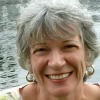
Lydia Biersteker grew up in Somerville, MA. She met her husband Dale on the beach at Falmouth Heights in 1969, while he was stationed at Fort Devens. After Dale retired in 2005 from his executive position with the USPS, they moved to Vero Beach, FL but decided that they preferred New England. They moved to Southport in 2011. Dale plays golf, and Lydia likes gardening, walking, writing poetry and short prose, exploring genealogy, and lunching with friends. Together, they enjoy dining, exploring wineries and brew pubs, walking the trails of Cape Cod, traveling and playing with their grandkids, who live on the North Shore.
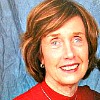 Joyce Chasson grew up in Pleasantville, NY, attended college in Boston, graduated from Boston University's School of Management and went to work for Houghton Mifflin in Boston. When her husband was drafted into the Army and stationed in Germany, she worked for the Red Cross. They moved to the Cape in 1972, bought a bar in Hyannis and expanded it into a successful restaurant. Joyce has retinitis pigmentosa and has been visually impaired since 1990. While working at the Cape Cod Community College, assisting women on welfare, Joyce developed an expertise helping people with disabilities. When the college established the O'Neill Center for Disability Services in 1992, she was appointed director and remained in the job until she retired in 2008. She left her home of 42 years in Osterville and moved to Southport in 2014, along with her Black Lab companion and guide dog Jason. Joyce is the mother of a daughter, Alexandria, and has three grandchildren. Joyce Chasson grew up in Pleasantville, NY, attended college in Boston, graduated from Boston University's School of Management and went to work for Houghton Mifflin in Boston. When her husband was drafted into the Army and stationed in Germany, she worked for the Red Cross. They moved to the Cape in 1972, bought a bar in Hyannis and expanded it into a successful restaurant. Joyce has retinitis pigmentosa and has been visually impaired since 1990. While working at the Cape Cod Community College, assisting women on welfare, Joyce developed an expertise helping people with disabilities. When the college established the O'Neill Center for Disability Services in 1992, she was appointed director and remained in the job until she retired in 2008. She left her home of 42 years in Osterville and moved to Southport in 2014, along with her Black Lab companion and guide dog Jason. Joyce is the mother of a daughter, Alexandria, and has three grandchildren.
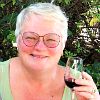 Lynn Fulton has lived in 32 different places before arriving in the summer of 2015 at Southport, most in New England, but there was also Tacoma and Quebec. She's been a waitress, hostess, bartender, ski lodge manager and chef, office worker, educator - high school, university and consultant, amateur architect and artist. Most of her pastimes have involved going from here to there - white water canoeing, kayaking, bicycling, hiking, climbing, backpacking, skiing and traveling. She's most proud of her 800-mile bicycle tour of the UK and the cross-country ski up and down Mt. Washington. She begins her seventh decade, having had both knees replaced, thrilled with the pool, hot tub, water aerobics and chair yoga at Southport, delighted with the social life and fascinating people. Lynn Fulton has lived in 32 different places before arriving in the summer of 2015 at Southport, most in New England, but there was also Tacoma and Quebec. She's been a waitress, hostess, bartender, ski lodge manager and chef, office worker, educator - high school, university and consultant, amateur architect and artist. Most of her pastimes have involved going from here to there - white water canoeing, kayaking, bicycling, hiking, climbing, backpacking, skiing and traveling. She's most proud of her 800-mile bicycle tour of the UK and the cross-country ski up and down Mt. Washington. She begins her seventh decade, having had both knees replaced, thrilled with the pool, hot tub, water aerobics and chair yoga at Southport, delighted with the social life and fascinating people.
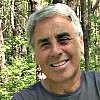 Andy Jablon owns a television production company in Watertown that provides crews to shoot stories in New England for the major TV networks. As producer, he interviews all sorts of interesting people on a regular basis. His wife TracyTebbutt works at a cancer pharmaceutical company in Cambridge. Since July 2014, they split their time between Southport and Boston, depending on work schedules. Both are enthusiastic cyclists, riding their bikes along the Charles River to work in almost all kinds of weather. At Southport, they relax by walking, biking, playing tennis and soaking in the hot tub. Andy Jablon owns a television production company in Watertown that provides crews to shoot stories in New England for the major TV networks. As producer, he interviews all sorts of interesting people on a regular basis. His wife TracyTebbutt works at a cancer pharmaceutical company in Cambridge. Since July 2014, they split their time between Southport and Boston, depending on work schedules. Both are enthusiastic cyclists, riding their bikes along the Charles River to work in almost all kinds of weather. At Southport, they relax by walking, biking, playing tennis and soaking in the hot tub.
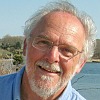 David Kapp, with his wife Billie, moved from Connecticut to Southport in 2009. David retired from a career as a university library administrator, after working in the libraries at Brandeis, Harvard and the University of Connecticut. He was a building consultant for the planning of a number of major university libraries and was, for many years, the editor of Connecticut Libraries. Billie enjoyed a career as an educator and social sciences consultant. The Kapps are frequent visitors to Hawaii where their daughter, son, grandson and many other family members live. David Kapp, with his wife Billie, moved from Connecticut to Southport in 2009. David retired from a career as a university library administrator, after working in the libraries at Brandeis, Harvard and the University of Connecticut. He was a building consultant for the planning of a number of major university libraries and was, for many years, the editor of Connecticut Libraries. Billie enjoyed a career as an educator and social sciences consultant. The Kapps are frequent visitors to Hawaii where their daughter, son, grandson and many other family members live.
 Bob Keeling grew up in Sharon, MA , moved to East Falmouth in 1990, and to Southport in 2015. He is a graduate of the New England Institute of Applied Arts and Sciences in Boston and the National Aviation Academy in St. Petersburg, FL. Bob is a former US Marine and corporate pilot, a flight instructor for airplanes and instruments, and a ground instructor. He's been a financial planner with Keeling Financial Strategies in Mashpee for 24 years. Bob volunteers with Hospice and is a volunteer Reiki practitioner with people and animals. He's the former director and chairman of the board of Hope Health Care in Hyannis. Bob is single; his daughter Beth lives in Walpole, MA, and his son Bryan lives in Kansas. He has three grandchildren, loves dogs and has traveled extensively. On his first trip to Bermuda, he piloted a small twin engine plane from Nantucket to Bermuda and back. Bob Keeling grew up in Sharon, MA , moved to East Falmouth in 1990, and to Southport in 2015. He is a graduate of the New England Institute of Applied Arts and Sciences in Boston and the National Aviation Academy in St. Petersburg, FL. Bob is a former US Marine and corporate pilot, a flight instructor for airplanes and instruments, and a ground instructor. He's been a financial planner with Keeling Financial Strategies in Mashpee for 24 years. Bob volunteers with Hospice and is a volunteer Reiki practitioner with people and animals. He's the former director and chairman of the board of Hope Health Care in Hyannis. Bob is single; his daughter Beth lives in Walpole, MA, and his son Bryan lives in Kansas. He has three grandchildren, loves dogs and has traveled extensively. On his first trip to Bermuda, he piloted a small twin engine plane from Nantucket to Bermuda and back.
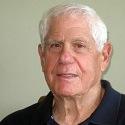 Bob Mendes Bob Mendes began his career as an advertising copywriter at Doyle Dane Bernbach in NYC before becoming senior vice president of marketing for a west coast department store chain. He left that position to start Pacific Sports, a sports and general marketing agency. There he developed "The Reading Team," a children's literacy program sponsored by the NFL and the American Library Association, using NFL players as literacy role models. Bob is the author of "A Twentieth Century Odyssey, the Bob Mathias Story." After retiring, he served as executive director of the Glendora, CA Chamber of Commerce. When grandson Adam was born, Bob and Bette moved to Cape Cod. He's had a number of part-time jobs, has written two more books, and volunteers. Bette serves on the Board of Governors and volunteers at the Falmouth Jewish Congregation. Their son Steve, a pediatrician, lives in Marion with his wife Sarah and their children; a second son, Jeff, practices law in Indianapolis.
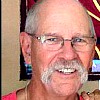 Dr. Richard Vengroff, emeritus professor of Political Science at the University of Connecticut, served for over 40 years in academe as both professor and for 12 years as a Dean. He specializes in comparative politics, having conducted fieldwork in 17 different countries. He has published and consulted widely on international development, elections and electoral systems and comparative immigration policy. He is beginning volunteer work here on the Cape with the Community Action Committee of Cape Cod and the Islands, (CACCI). He and his wife of 33 years, Cindy Hardin Vengroff, a museum educator, moved to Southport in May 2015. Dr. Richard Vengroff, emeritus professor of Political Science at the University of Connecticut, served for over 40 years in academe as both professor and for 12 years as a Dean. He specializes in comparative politics, having conducted fieldwork in 17 different countries. He has published and consulted widely on international development, elections and electoral systems and comparative immigration policy. He is beginning volunteer work here on the Cape with the Community Action Committee of Cape Cod and the Islands, (CACCI). He and his wife of 33 years, Cindy Hardin Vengroff, a museum educator, moved to Southport in May 2015.
 Carl Zuanelli graduated from SUNY/Maritime College at Throgs Neck, NY, received his Third Mate's License from the US Coast Guard and was commissioned as an ensign in the US Navy before embarking on a career in the Merchant Marine. Later, after earning his MBA at Iona College, he enjoyed a second career in corporate insurance - ocean, marine, commercial, casualty and domestic & international reinsurance. When his son wanted to begin a business of his own, Carl helped him out and joined the board of the fledgling Board of the Nuovo Pasta Company; pasta was a good investment. He served as a trustee of the Westchester Artificial Kidney Foundation for 30 years and on the Wilton (CT) Board of Finance for five. A widower, he retired in 1996 and in 2003 moved to Southport to be with his new wife Leslie. He is the father of two sons and two daughters. Carl Zuanelli graduated from SUNY/Maritime College at Throgs Neck, NY, received his Third Mate's License from the US Coast Guard and was commissioned as an ensign in the US Navy before embarking on a career in the Merchant Marine. Later, after earning his MBA at Iona College, he enjoyed a second career in corporate insurance - ocean, marine, commercial, casualty and domestic & international reinsurance. When his son wanted to begin a business of his own, Carl helped him out and joined the board of the fledgling Board of the Nuovo Pasta Company; pasta was a good investment. He served as a trustee of the Westchester Artificial Kidney Foundation for 30 years and on the Wilton (CT) Board of Finance for five. A widower, he retired in 1996 and in 2003 moved to Southport to be with his new wife Leslie. He is the father of two sons and two daughters.
Special Thanks To
Bob Fulton for help with the Pioneers article,
Joan Bailey, Billie Kapp & Lydia Merchant
for the story about Tigger,
And to my proofreader Billie Kapp
|
|
|
|
|
|
|
|